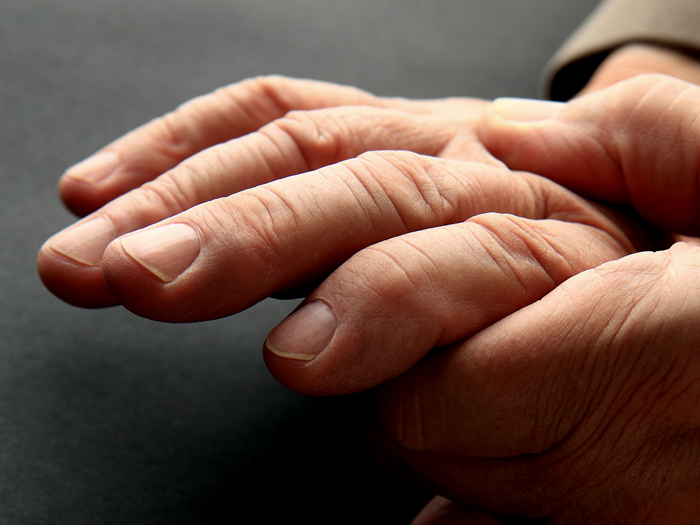11 Reasons You Have Swollen Fingers
Puffiness is often harmless, but it may signal something more serious. Here’s how to spot the difference.

Fingers swell for a lot of reasons. Many are harmless—like you downed a salty meal last night—but sometimes swollen fingers may signal a more serious health condition.
Before we dive into the different reasons your fingers may swell, here’s an important cautionary note: If your fingers swell often—more than once a week, for example—you can’t pinpoint a cause, or the swelling doesn’t seem to subside, see a physician, says Karishma Ramsubeik, M.D., an assistant professor of rheumatology and clinical immunology at the University of Florida College of Medicine.
Immediate medical attention is also necessary if you have swelling and other symptoms such as fever, chills, or redness or warmth of the finger.
“If there’s persistent joint swelling, there’s the risk of irreversible joint damage that could lead to deformity and loss of function,” Dr. Ramsubeik says. “This can certainly affect one’s quality of life, so it’s not something you want to ignore or deal with on your own.”
Diagnosis often begins with a primary care physician, who performs a physical exam and may do blood or imaging tests. The doctor should be able to determine whether the swelling needs further evaluation by a rheumatologist or other specialist.
With that warning behind us, here are 11 common causes of swollen fingers you should know—and when to call your doctor.
1. Arthritis
If the swelling is primarily around the joints, you may have arthritis—50 percent of adults age 65 and older do, according to the Centers for Disease Control and Prevention.
Osteoarthritis, the “wear and tear” form of the condition, is the most common. As bone cartilage wears down over time, bony growths develop near the joint, creating the appearance of swelling, Dr. Ramsubeik says.
Most cases can be managed with medication and lifestyle changes. However, if the swelling is accompanied by heat and pain, it could indicate an inflammatory form of arthritis, like rheumatoid arthritis or gout, or arthritis brought on by lupus. These types of arthritis tend to be tied to a larger underlying issue, such as an autoimmune disorder.
If your entire digit is swollen, not just the joints, then psoriatic arthritis may be the culprit. This is especially true if you’ve been diagnosed with psoriasis, a related skin condition that causes thick, scaly patches.
The time of day when you notice symptoms may provide another clue. Arthritis sufferers tend to see symptoms in the morning, says Jarod DuVall, M.D., an internist at UCLA Health. “Your hands actually improve with activity throughout the day,” he says. “If you overdo it, they might get worse again in the evening.”
If morning stiffness resolves within a half-hour, osteoarthritis is more likely, Dr. DuVall says. But those with inflammatory arthritis tend to suffer for longer than 30 minutes—up to an hour of stiffness and swelling in the morning.
If any of this sounds familiar, schedule a doctor’s visit to learn whether arthritis is to blame and how you can treat it. Plus, ask you can exercise safely with arthritis. Staying active can help joints stay healthy and improve quality of life.
2. Infection
Get any paper cuts lately? Bacteria can sneak into even small cuts, cracks, or wounds, leading to an infection that may cause swelling.
“Any breakdown in the skin, mild or severe, puts you at risk for infection,” Dr. DuVall says. “And some patients, like people with diabetes, whose immune systems aren’t working quite as well, are at higher risk.”
One common bacterial infection that can affect the whole hand is known as cellulitis, which can become life-threatening if left untreated. Other types can occur at the fingertip and cause fluid to collect under the nail.
Infection in the knuckles can be serious and require immediate treatment, possibly surgery, says John Ingari, M.D., chief of hand surgery at Johns Hopkins Medicine.
“If, say, an animal bites you on the hand, its teeth can penetrate the joint and leave germs behind,” Dr. Ingari says. “That joint will become red, hot, and painful within hours to days.”
As mentioned above, if the swelling is accompanied by bright redness, heat, pain, fever, or chills, call the doctor right away to check for infection. Also, take preventive measures anytime you break the skin. Clean the area well with soap and water, and keep it dry after that.
3. Circulation Problems
Put a tight bracelet on your wrist, and you restrict blood flow. Your powerful arteries can pump blood in, but the much weaker veins can’t get it out. As a result, it builds up, and your hand swells. The fix? Take off the bracelet, of course.
But other circulation problems are not so easy to resolve. Lymphedema, for example, occurs when your lymph vessels are unable to drain lymphatic fluid from a limb. It can happen anytime the lymph nodes or lymph vessels suffer damage, such as from surgery. Generally, swelling occurs not just in the fingers, but the entire hand and arm as well, Dr. Ramsubeik says.
Consider your medical and family history, Dr. Ingari advises. Breast cancer patients who’ve had their lymph nodes surgically removed may be at risk for lymphedema. If that’s you, schedule an appointment with your doctor to learn more about treatment options.
4. Autoimmune Disease
In autoimmune diseases like lupus, the body’s immune system attacks its own tissues by mistake, causing inflammation. The skin, kidneys, brain, lungs, or heart may be affected. If the joints are involved, it can lead to puffy fingers.
“No two cases of lupus are exactly alike,” Dr. Ramsubeik says. “The signs and symptoms depend on which body systems are affected.”
If you notice any joint pain, fatigue, unintentional weight loss, painless mouth sores, or a butterfly-shaped rash on your face that covers the cheeks and bridge of the nose, call the doctor to get checked out right away.
5. Injury
Bang your finger against a hard surface or hit it accidentally with a hammer, and you’ll trigger inflammation, “the body’s first line of immune defense after an injury,” Dr. Ramsubeik says. That can lead to swelling.
Ice the injury for 10 to 15 minutes at a time, two or three times per day, Dr. DuVall recommends. And try to keep it elevated above your heart as long as you can or until the swelling subsides.
“It’s easier if you’re sitting or lying down, because your heart is at a lower position,” he notes. “For example, you can prop it up on a pillow while you’re watching TV.”
You can also take over-the-counter nonsteroidal anti-inflammatory drugs (NSAIDs) for up to three days, as long as you don’t have any contraindications like kidney disease, uncontrolled hypertension, or a peptic ulcer, Dr. Ramsubeik says. To avoid serious side effects from OTC drugs, ask your doctor or pharmacist for guidance if you have any conditions or take any medications.
If the pain is significant, the injury appears serious, or you are unable to move the finger, have it checked out. You may have a fracture.
6. Heat or Exercise
Maybe you’ve noticed fat fingers after exercising or being outside on a hot day. That’s a sign that your body is trying to cool itself, just as sweating is.
“Our bodies try to maintain what’s called homeostasis, a body temperature of roughly 98.6 degrees,” Dr. Ingari says. When the temp starts to rise, your body pumps extra blood into your extremities so more heat can escape through the skin.
“It’s a very benign form of swelling and should go away within minutes to hours once you’re back in the air conditioning,” Dr. Ingari says.
If it bothers you, try moving your hand and fingers to boost circulation. Make a fist and then spread your fingers wide several times, he suggests.
As the weather gets warmer or as you travel to hotter climates, take preventive steps to stay cool and avoid heat stroke.
7. Carpal Tunnel Syndrome
If your fingers feel more swollen than they look, the culprit could be carpal tunnel syndrome, a common affliction that occurs when swelling in the surrounding tissue pinches the median nerve in the wrist. Usually pain, numbness, and tingling also come with the territory.
Subscribe to our newsletter
It's quick and easy. You could be one of the 13 million people who are eligible.
Already a member? Click to discover our 15,000+ participating locations.
Follow Us
Doctors typically recommend wearing a nighttime splint, which keeps your wrist in a neutral position during sleep. Corticosteroid injections may also provide relief, says Dr. Ingari, and surgery can be performed in more severe cases.
To learn more, check out our guide to four ways to relieve carpal tunnel pain.
8. A High-Salt Diet
Increased salt intake can lead to water retention and swelling in the hands, arms, feet, ankles, or legs.
Dr. DuVall recalls a vivid example from his days a medical student in Louisiana. “They love crawfish in Louisiana,” he says. “Crawfish boils have a lot of salt in them. We would frequently see people come in on a Monday for swelling in their legs, feet, or other areas. We’d ask them what they ate, and it would turn out they’d gone to a crawfish boil over the weekend.”
Your kidneys are constantly trying to balance the salt and fluid levels in your body, Dr. DuVall explains. So if the salt goes up, the kidneys release hormones to signal a boost in fluids to dilute the salt.
Mild swelling after a salty meal should go away within a day or so, and it’s nothing to worry about in healthy individuals.
However, some foods—like alcohol, red meat, shellfish, and those containing high fructose corn syrup—can trigger flare-ups in gout patients, Dr. Ramsubeik says. These foods can cause a buildup of uric acid, causing crystals to form and accumulate in and around joints.
If joint pain and swelling occur when you consume these foods, check in with your doctor. If gout is the cause, medication and dietary changes can help.
9. Kidney, Liver, or Heart Dysfunction
“Sometimes water retention is caused not just by diet, but by dysfunction in the kidneys, liver, or heart,” Dr. DuVall says.
If any of these organs is not working properly, then the body may hold on to excess fluid. That’s why some patients are instructed to limit their salt intake, he says.
If the swelling persists, or if you have risk factors like heart disease, high blood pressure, high cholesterol, or diabetes, talk to your doctor. Your doctor may increase your medication or even admit you to the hospital for treatment.
10. Allergies
If you recently used a new lotion or soap on your hands, then the swelling may be a symptom of contact dermatitis, an allergic reaction caused by direct contact with a substance—such as cosmetics, latex, or certain plants, Dr. DuVall says. If that’s the case, you’ll likely also have an itchy rash.
Wash the affected area with water and a gentle soap that’s free of heavy fragrances or dyes. Most cases clear up in two or three weeks, according to the National Institutes of Health. But if the skin reaction is severe or the rash hasn’t cleared up in that time, call your doctor.
Long-term treatment involves identifying and avoiding the cause of your reaction, which may require the help of an allergist.
11. Medications
Though it’s not common, some medications can cause swelling throughout the body, including the hands, Dr. DuVall says. These include some:
- Oral steroids
- Blood pressure medications
- Hormone treatments
- Diabetes drugs
- Anti-inflammatory medications, which can affect how well the kidneys can filter out excess fluid
Still, you should never stop taking a prescription medication without talking to your doctor first. If you’re concerned your meds may be causing swelling, call your doctor right away to get instructions.
Take Your Favorite SilverSneakers Classes Online!
SilverSneakers members can access live fitness classes and wellness workshops through SilverSneakers LIVE. See the latest schedule and RSVP for classes here.
Not a member? If you have a Medicare Plan, it may include SilverSneakers—at no additional cost. Check your eligibility instantly here.




